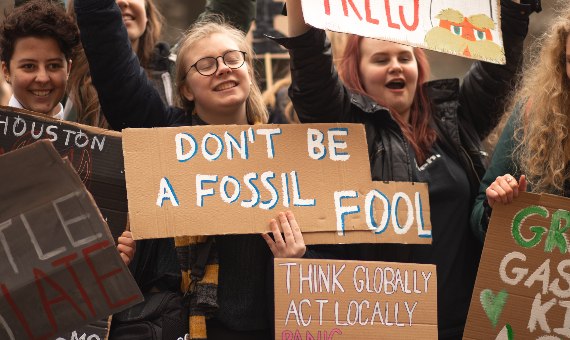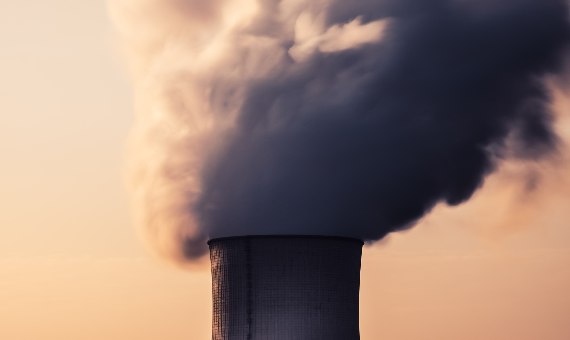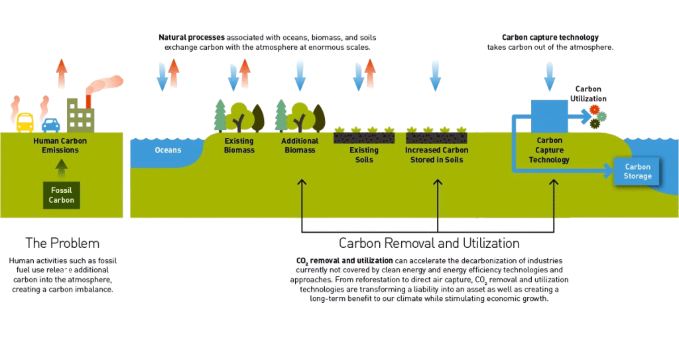If we apply the principles of a circular economy and recycle CO2 emissions we can accelerate the fight against global warming. It´s a battle that poses a complex challenge so that in addition to reducing emissions with clean energies such as solar energy or electric cars, we begin using technologies like carbon capture, utilization and storage, or CCUS , which aim to eliminate CO2 already released into the atmosphere by capturing it and converting it into raw material for useful non-polluting products. So, is it possible to make CO2 an ally for climate action?
Volker Sick is a professor of mechanical engineering at the University of Michigan (United States) and directs the Global CO2 Initiative, a project at said university to drive the development of CCUS technologies that can capture and convert carbon dioxide into useful products. In a conversation with OpenMind, Professor Sick acknowledged that, “Even when we stop using fossil fuels, processes such as cement and steel production will continue to emit CO2.” This is where the perspective of this global public policy research and analysis initiative comes into play: to make it economically and technologically feasible to recycle CO2 from the atmosphere and use it to make new materials.

CCUS: technologies allied with SDGs and the Paris Agreement
CCUS technologies are a requirement to meet the climate objectives of the Paris Agreement and curb global warming below 2ºC for the Intergovernmental Panel on Climate Change (IPCC) and the International Energy Agency (IEA). CCUS technologies would reduce about one sixth of the emission reductions needed to meet this goal by 2050.
According to the IEA, there are currently several large-scale CCUS energy technology projects in operation with a combined capture capacity of 2.4 megatons of CO2 per year, a figure that is far from reaching the levels proposed by the United Nations´ Sustainable Development Goals: 310 Mt (megatons) of CO2 each year by 2030, as recognized by the agency itself. According to the calculations of the same agency, up to 40 million tons of CO2 derived from electrical and industrial installations would have been captured annually as of 2020.

Before the Paris Agreement was signed, the Synthesis Report of the IPCC Fifth Assessment Report estimated that without CCUS technologies the economic cost of fighting climate change would increase by 138%. Although the majority of CCUS projects are located in the United States and Europe, projects are also being planned in Australia, China, Korea, the Middle East and New Zealand, according to the IEA initiative map. If ultimately carried out, this roadmap would allow the global amount of CO2 currently captured to triple, reaching around 130 Mt per year.
Capturing and deconstructing CO2: a technological process key to climate action
Many of the products we use contain carbon, and based on this fact the CO2 that we expel into the atmosphere can be reused to produce them, instead of extracting more carbon from fossil fuels, as is currently the case. As Volker Sick argued to OpenMind, “The idea of using CO2 to make products is not new and has been examined on and off for several decades, especially with regard to enhanced oil storage and recovery, which has been around for fifty years now.” However, implementing the idea of reusing the CO2 that we produce on a large scale implies a significant technological development, since it is necessary to transform CO2 molecules into carbon molecules, a process that requires an energy supply that must come from energy sources of zero carbon, to avoid adding more CO2 emissions. In this sense, the director of The Global CO2 Initiative warns that, although “The global availability of renewable energy has increased substantially during the last decades, massive investments in research, development and implementation will be needed to make CCUS technologies a reality and generate a real impact for the environment and to create new jobs.”

Volker Sick explains that a problem with an efficient use of CO2 as a raw material is the capture process itself: “You need big machines and, actually, a lot of energy to separate the CO2 from the combustion gases and especially from the air. Once the CO2 is available in a concentrated way, the catalysts facilitate the conversion of this CO2 and water into chemicals.” It is precisely the development of these catalysts that the laboratories of The CO2 Global Initiative are at work on, where they are already experimenting with the production of methanol as an alternative to fossil fuels or a self-repairing concrete that turns the gases that now pollute our atmosphere into stone.
Methanol, natural fibers and a flexible CO2-based cement
“Methanol can be used in the production of many other chemicals, including carbon fiber. It is even possible to convert methanol into a fuel that can replace diesel and that burns much cleaner,” says Volker Sick. He explains how one of the research teams also works with plants such as hemp, flax and bamboo to involve nature in the process of the deconstruction of CO2. For this, fibers are extracted from these plants to use them in composite materials to replace glass fibers, “And they have even been included in concrete to improve their properties,” says the director of the initiative, who also recognizes that “for all this to work, it is necessary to manipulate these fibers and that is where part of our group’s research is focused.” Volker Sick also indicates that, beyond methanol or vegetable fibers, “the biggest opportunity to remove CO2 from the atmosphere is to lock it in concrete and other building materials. In fact, it is important to understand that when we pump CO2 into a mixture of concrete, CO2 turns into rock! Therefore, it will never go out into the atmosphere again, not even if the concrete breaks.”
Despite the promising horizon that this would mean for many industries, the democratization process of these CCUS technologies faces two major barriers, as recognized by Volker Sick: “One is cost and the other is related to standards and codes. In both cases, adequate political work is necessary and, therefore, at The Global C02 Initiative we work with legislators, politicians and sanctioning bodies to help update or even create new policies that facilitate the adoption and promotion of these technologies. ”
Comments on this publication